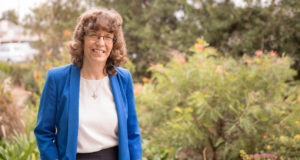Digital technology can be a powerful tool for the church, whether it’s being used for ministry, administration or general communications. Ashley Thompson and Ben Rogers meet some global leaders in the faith-tech space and talk to members of the Uniting Church community in Queensland about what is being done closer to home.
In the constantly evolving landscape of digital technology churches are faced with an exciting but sometimes daunting challenge as they grapple with how best to use a vast array of social media platforms, apps, software packages and multimedia technologies to share the Gospel.
The world’s most popular Bible application, YouVersion has been downloaded over 280 million times, features 1492 Bible versions and is available in 1074 languages.
What may surprise you is that it was developed by a local church in Oklahoma County in North America.
“It’s not a technology hotbed,” Life.Church Innovation Leader Bobby Gruenewald explains. “I always say that if a group out of Silicon Valley or Google started the Bible app then most people would think ‘well, that makes a lot of sense’.
“The fact that God chose to use a church in Oklahoma as a catalyst [for innovation] is really because there’s no way for us to take credit for the success of it, it doesn’t make sense, and it allows him to be the key variable of the story.”
A global leader flying under the radar
Named by Newsmax as the largest church in America and yet “you probably wouldn’t even know it”, Life.Church’s 27 locations across eight states regularly pushes 100,000 in weekly attendance, while their Church Online attendance doubles that. It’s this embrace of new media over traditional broadcast that has let them fly under the radar while more overtly charismatic US churches take centre stage.
“We view technology as a tool for mission, that’s all that it is. In the same way a new facility is viewed,” says Bobby. “I always say that technology can help effective churches in their mission but it can’t help ineffective churches all of a sudden become effective.”
However, as Bobby freely points out, Life.Church is not alone is its uptake or embrace of technology, neither in the past or present day. “There used to be a time a few hundred years ago where the church was the epicentre of creativity,” he says, “[the] influential centre of the city where art and innovation would have emanated.”
And while that status in society may have deteriorated in more recent years, numerous churches have risen to the challenge of becoming an “influencer of culture” rather than simply trying to reach it, Life.Church included.
“What was important to the success of [YouVersion] was that we tried to be really quick to recognise what God was doing,” says Bobby.
A successful businessman and tech entrepreneur in the 1990s, Bobby Gruenewald was, in both the cases of Church Online and YouVersion, waiting for the technology to catch up to his team’s vision. It was this attunement to industry trends that allowed the YouVersion Bible app, submitted to the Apple Store in June 2008, to become one of the first 200 Apple mobile applications ever. There are now over 2.2 million.
“We believe it’s something that God orchestrated because there’s no real reason how, it wasn’t just available early but has grown and sustained in success over the last nine years,” says Bobby who made Fast Company’s 2011 list of The 100 Most Creative People in Business.
Funded by general giving and a handful of outside donors, YouVersion now has 32 full-time staff, a portion of the eight per cent of Life.Church staff devoted to digital mission.
“We’re really getting behind what God’s blessing and it’s not that we got in front of it, it’s that we got behind it.”
Bringing church, online
Before the YouVersion Bible app there was Church Online. A novel concept back in 2006, today the platform reaches over 200,000 unique visitors each week through 71 different service times. In addition to eight full-time Church Online staff members, more than 460 volunteers serve at Church Online from approximately 30 countries around the world. In Australia, there are five regular volunteers.
Host Team Community Leader and Central Victoria resident Katrina Soulsby knows the struggle of explaining the concept to her uninitiated Christian friends, “Most people don’t understand the concept of Church Online to which I’ll respond, well it’s church … online.”
“[The concept] is a challenge for a lot of people,” says Katrina. “But we’re so connected to our phones all the time, it’s quite natural that church could move into an online environment and it’s actually a pretty big place in which you can connect with people who don’t know Jesus.
“It’s a light in a lot of darkness.”
Accessible via the Life.Church URL, Katrina now calls Life.Church her home church, despite the 15,000+ distance between her and the closest physical campus.
Initially hearing about the concept from Life.Church Senior Pastor Craig Groeschel back at a Global Leadership Summit in 2007, Katrina didn’t connect with the ministry until she began searching for English messages while serving on mission in Peru. Then three years ago, when her local church changed its service time to a Monday night to coincide their soup kitchen, she decided to give it a regular go.
“When I started attending Church Online, it was never going to be a long term solution, but now some of my closest friends are from Church Online. It’s quite surprising the connection you make with people who attend the same online church each week.”
So, how does it work? Users login with an account or guest login and then join in on a live service in which they are able to chat to hosts and other guests while the message is on. Users can chat in group settings or requests live one-on-one prayer. Can’t make a particular service time? On-demand messages are available 24/7.
“I really feel like that’s where I’ve been called to in my life right now,” says Katrina who has launched five new experiences at Church Online and started a Facebook group for Australian Life.Church attendees—now with over 150 members.
“You’ve still got to put the effort and time into those relationships—people say you can hide online and well, you can but people can hide face-to-face too. So you’ve got to be prepared to be honest online just as offline.”
Channelling God
From online to broadcast media: Hillsong Church is another example of a global Christian church using technology to spread the Gospel, namely through the recent addition of their broadcast network, Hillsong Channel which launched in June 2016.
At Hillsong Conference Sydney, in July, Journey sat down with the Head of Film and Television for Hillsong Church Ben Field to discuss the church’s vision for the channel—and the deeply ingrained cultural elements that allow online ministries to thrive.
“Our vision as a church is to influence the world through Bible-centred Christ-filled churches,” Ben says simply. “And our channel’s different [from others] in that it comes out of the strength and the heartbeat of a local church.”
The youngest director in Australia at 29, Ben gave up a gig on Australian flagship soap drama Home and Away to put his hands to “creating a tangible change in people’s lives.”
After only a year, Hillsong Channel reaches 165 million homes around the world, excluding streaming services, Europe and Australia. Since launching, they have also lowered the average age of Christian television viewership from 45+ to 25-years-old and will launch an on-demand platform in September this year.
“It’s absolutely incredible—we’ll be in the most remote part of Africa and people will pull out their Samsung and start watching YouTube videos—and so the opportunity’s huge to reach people and people who often won’t darken the door of the church.
“That’s the power of the channel.”
There’s really no secret formula to the technological success of churches like Life.Church and Hillsong Church. As Ben Field puts it: “The church, and building faith in people, is the prize.
“It’s not me going, ‘let’s do great TV’ or someone who’s a solo artist saying, ‘I want to be the biggest Christian artist’, everyone dies to all of that. It’s about building the local church and loving people, and I think out of that has come all these amazing opportunities because there’s a healthy core.”
Global technology, local focus
Closer to home, while there is still plenty of room for development in how Uniting Churches in Queensland embrace innovative digital technology, some congregations are already forging ahead with new platforms and software to enhance the Gospel message.
For Newlife Uniting Church this means a continuous examination of what is available that best meets the need to effectively communicate, inspire creativity and improve efficiencies.
“We are constantly looking at how technology can support and enhance how we conduct corporate worship, streamline our systems and processes as well as inspire new ways of communicating the Gospel message beyond Sunday,” says Craig Hindman, Newlife’s creative arts pastor.
“I like to see technology as a neutral tool which can be used to draw people’s gaze toward the beauty of who Jesus is, or away from it.”
When it comes to enhancing corporate worship Craig recommends congregations explore software such as ProPresenter (lyric and media presentation software for worship gatherings), Multitracks (instrument tracks for when a congregation may not have a full suite of musicians) and Mainstage 3 (“You can plug your laptop into your midi keyboard for an unlimited array of sounds, from piano to strings to synth patches”).
For administrative requirements, Craig encourages people to check out management software tools such as Elvanto, Planning Centre Online and UCare.
At Cleveland Uniting Church the use of email, SMS and social media has been critical for staying in touch and connecting with the community outside of physical material handed out or announcements at church.
Rev Stephen Rothery, Cleveland’s youth and families minister, says, “Gone are the days of the church being the central hub of the community and gone are the days of the average worshipper attending every single week.
“No matter how dedicated a volunteer might be, they will spend more time at home or at work, than they do in worship services, Bible study groups and meetings. Current communication technologies make it far easier and cheaper to provide resources to form faith at home than ever before.”
Like Craig’s recommendation of management software, Stephen says software like Elvanto makes it “far easier to see the community through the crowd”.
“After experiencing a few years of slow but steady growth, we quickly discovered that almost all of our systems and processes were geared towards a static or declining congregation. Bringing together things like record keeping, service planning, rostering, pastoral care saves time for the team and helps us avoid losing people through the cracks. These days this is a must for any church of over 50 people.”
The Queensland Synod is also keen to embrace digital innovation as part of its priority directions and is already undertaking a range of initiatives to connect with congregations, especially younger people.
Rev David Fender, Associate General Secretary, insists that this embrace is evolutionary and continues a long tradition of using what is available to very best respond to God.
“We’re finding a disruptive way through which we can continue to evolve, the very nature of humanity, of life, of faith is that it grows … Technology comes in, it becomes new and we worry about what we’re losing but we need to find the way it serves us, rather than us serving the technology.”
This year’s Synod in Session participants will also get to experience the Queensland Synod’s first ever use of Slido software to facilitate greater conversation during the event.
“Slido is a web-based application that allows questions and answers,” says David. “Members of Synod will be able to access the reports online before the meeting and they can submit questions, they can submit answers to other people’s questions, they can hear answers from report authors. It engages in a conversation before the Synod in Session meets.
“It particularly taps in to people who are more native to the digital environment and its recognising a new and emerging generation.”
Future proofing
Whether speaking to the creative minds behind internationally-renowned digital innovations or ministers in Queensland churches, one thing unites their passion for technology: its ability to carry out the mission of God.
For David Fender the bottom line is that, “it’s not the technology that we’re worshipping, it’s the God who we worship through technology” and we must “never lose the sense of what it means to connect personally with others” whether that’s online or face-to-face.
Craig Hindman echoes the latter sentiment, “The church is going to need to embrace online communication methods more and more. Engaging with social media as a necessary part of our discipleship and evangelism strategy is critical … not in place of, but in partnership with our face-to-face strategy.”
While the opportunities abound for enhancing the mission using digital technology, Stephen Rothery has a blunt warning for those unwilling to evolve in the years to come.
“Failure to embrace technology that seems normal to a 10-year-old today will make long term health and relevance for the church impossible.”
 JourneyOnline
JourneyOnline






